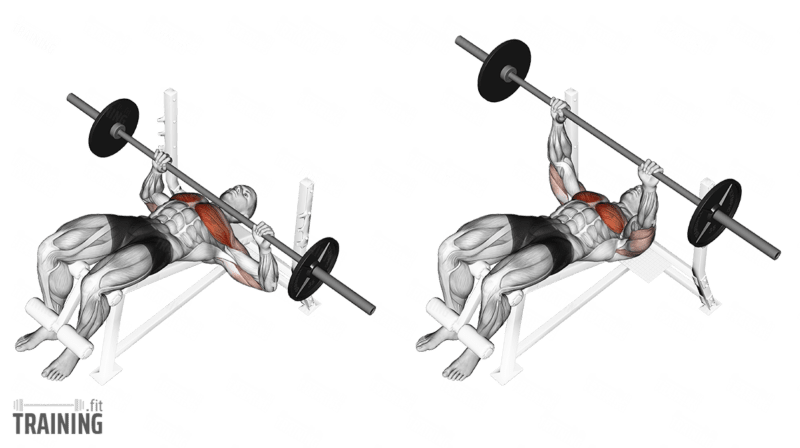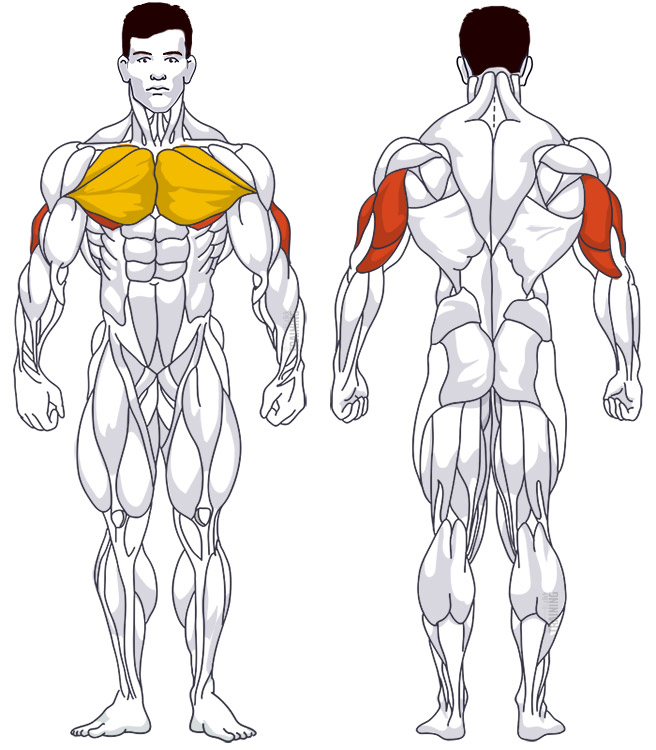Decline Bench Press
Compound exercise, Free weightsOverview

Main muscles
- Chest: Large pectoral muscle
(Musculus pectoralis major) - Chest: Small pectoral muscle
(Musculus pectoralis minor) - Triceps: Three-headed arm muscle
(Musculus triceps brachii)
Training plans
Here you can find example plans for decline bench press training:
Decline Bench Press: Basics and alternatives

Involved main muscle groups:
Decline Bench Press
The decline bench press is a popular alternative to the classic bench press. The main difference is the angled backrest, causing your upper body to lean downward, which changes the arm movement angle. As a result, the decline bench press targets the lower chest more effectively.
The basic movement is the same as the flat bench press: while lying on the decline bench, you push the barbell upward from your chest.
Other lower chest exercises include dumbbell decline bench press and negative flys. Besides the classic flat bench press, you can also try close grip bench press or resistance band chest press.
Correct execution
Even though the bench press movement, including the decline bench press, appears simple, it requires attention and practice to perform correctly. The lying position, grip, descent position, shoulder posture, and movement can all lead to errors.
Since bench press variations often involve heavy weights, it’s crucial to perfect the movement as soon as possible. Beginners should practice with an empty barbell and gradually increase the weight. Filming yourself from different angles can help ensure you’re performing the exercise correctly, reducing long-term shoulder joint problems and injury risk.
A shoulder-width (or slightly wider) grip is recommended. A wider grip relies more on the shoulders, while a narrower grip increases triceps activation.
Video tutorial
Step-by-Step Guide
Lie on the decline bench with the barbell level with your upper chest in the holder.
Secure your legs in the designated padding.
Pull your shoulder blades back.
Extend your arms, grip the barbell shoulder-width apart (or slightly wider).
Always use a closed grip with your thumb around the bar, not a “monkey grip” (open grip).
Lift the barbell out of the holder.
Lower the bar evenly and under control above your chest, keeping your elbows from flaring too far outwards.
Keep your shoulder blades drawn in and inhale as you lower the bar.
Due to the bench angle, the barbell will land lower than usual, around your nipples or lower chest, depending on your anatomy.
Perform the upward movement cleanly and quickly, exhaling as you do so.
At the top, maintain body tension, don’t fully extend your arms, and repeat the process.
Common Mistakes and Injuries
Make sure not to use too much weight and train in a power rack with safety catches set low if you’re working out alone.
Always use a closed grip, not a monkey grip (open grip), to prevent the barbell from rolling.
Don’t use momentum to lift the weight. Each step of the movement should be clean and controlled for the best training effect.